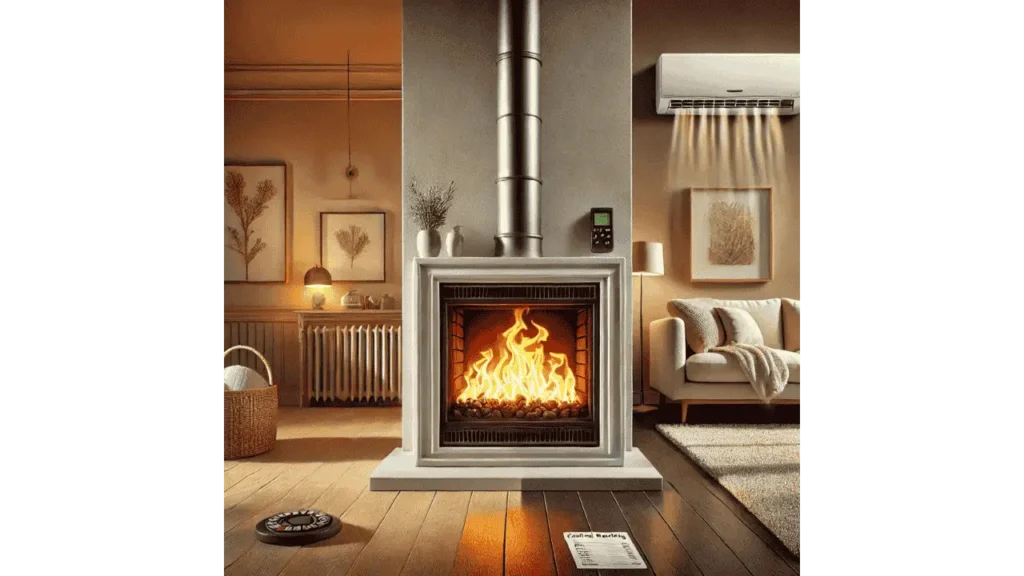With energy bills on the rise, figuring out whether to heat your home with a gas fireplace or central heating can be tricky. Both have their costs and benefits, and choosing the right option can make a big difference in keeping your living space warm without breaking the bank. Having faced this choice myself, I know it helps to have a clear look at what each option really costs. In this guide, we’ll break down the expenses of both, explain how current gas prices factor in, and share simple ways to save on heating, so you can stay cozy and budget-friendly this winter.
Gas fire versus central heating – what’s the cheapest way to warm up your living room?
When it comes to keeping your living room warm, deciding between a gas fireplace and central heating can make a big difference in your energy costs. Gas fireplaces are great for heating specific areas quickly, while central heating warms up the whole house. If you mostly spend time in the living room, running a gas fire may cost less than heating the entire home. However, if you want consistent warmth throughout, central heating might be the better choice. In this guide, we’ll break down the costs, so you can choose the best and most budget-friendly option for your home this winter.
Gas fire versus central heating – which is cheaper to heat your living room?
When it comes to costs, both central heating and gas fireplaces have their pros and cons. Understanding how each one affects your energy bill can help you decide which option will keep your living room cozy without overspending. Let’s break down the basics of each.
How much does central heating cost?
Central heating costs vary depending on your home’s size, insulation, and the efficiency of your heating system. Typically, central heating uses natural gas or electricity to warm every room, meaning you’re heating areas even if you’re not using them. On average, central heating can cost more per hour than running a single gas fireplace, especially if your system isn’t energy efficient or you have a large space to heat.
How much do gas fires cost to run?
Gas fireplaces focus heat in one area, so they can be a cost-effective choice if you’re mainly looking to warm up your living room. Their operating costs depend on the gas type and the fireplace’s efficiency, but they generally use less fuel than a whole-house system. Plus, since they provide direct warmth, you might be able to turn down the central heating, reducing your overall energy consumption.
Is central heating cheaper than a gas fire?
The answer to whether central heating or a gas fire is cheaper depends on your home’s layout, insulation, and your heating habits. Generally, central heating can be more cost-effective if you’re heating multiple rooms frequently, as it distributes warmth throughout the house. However, if you’re just looking to keep one area, like the living room, cozy, a gas fire might offer better savings by focusing heat where you need it most.
How to tell which is cheaper for your home
To find out which option is cheaper for you, compare your gas and electric rates and take note of how often you use each heating source. Try running the gas fireplace during peak living room hours, then see if you can reduce your central heating use overall. Also, consider insulation, better-insulated spaces retain heat longer, meaning you may not need as much heating from either source.
How much is gas right now – is it expensive?
Gas prices can fluctuate based on supply, demand, and even seasonal factors. Recently, gas costs have been on the rise in many areas, which can impact the cost-effectiveness of running a gas fireplace. It’s a good idea to check your local rates or recent utility bills to see if gas prices are particularly high. This will help you determine if using a gas fire or relying more on central heating makes better sense for your budget this season.
What can I do to cut the cost of central heating or a gas fire over winter?
Keeping heating costs down is a priority for many of us, especially during the colder months. Whether you rely on central heating, a gas fire, or a combination of both, a few simple adjustments can make a big difference in your energy bills. Here are some practical ways to save:
1. Use heating controls
Heating controls, like programmable thermostats or zoned heating systems, allow you to set specific temperatures for different times of the day or even for individual rooms. By reducing heating when you’re asleep or out of the house, you’ll avoid unnecessary energy use and save on both central heating and gas fire costs.
2. Install thermal blinds or curtains
Thermal blinds and heavy curtains add an extra layer of insulation to your windows, keeping warmth inside where you want it. These coverings reduce heat loss significantly, allowing you to lower the thermostat and still keep the room cozy, no matter which heating source you’re using.
3. Turn the thermostat down
Lowering your thermostat by even one or two degrees can have a noticeable impact on your energy bill over time. Instead of cranking the heat, consider bundling up with blankets or sweaters. This small change allows you to enjoy a comfortable space while keeping energy costs under control.
Bottom Line
Deciding between a gas fireplace and central heating comes down to your home’s needs, energy costs, and how much of the house you want to keep warm. By understanding the costs and adjusting simple things like thermostat settings and insulation, you can enjoy a cozy space without overspending. With a few mindful choices, staying warm and saving on energy costs this winter is entirely possible!
- 27 Farmhouse Fireplace Ideas That Bring Warmth & Charm - August 18, 2025
- 25 Fireplace Lighting Ideas to Illuminate Your Hearth - August 7, 2025
- How to Replace an Electric Fireplace Switch? - August 5, 2025



